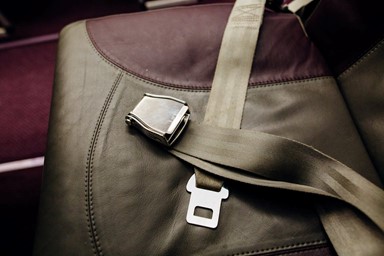Using seat belts saves thousands of lives every year. In the United States, the national use of seat belts in 2020 stands at 90.3%.
Wearing seat belts is the most effective way to minimize injuries and save lives in a collision. They hold back drivers and passengers from being ejected. As many as 3 out of 4 people who are ejected during a car crash sustain fatal injuries.
Short History of Seat Belts
Seat belts were initially invented for workers who needed to be held safely, such as painters, tourists, and firemen. Later in the 1950s, a doctor in California conducted a study that revealed how these belts led to a decrease in head injuries at a hospital he was employed at.
After his study was published, car manufacturers began to implement his idea of a retractable seat belt for vehicles. Nash and Ford were the first car companies to introduce them.
How Does a Seat Belt Work?
A seat belt minimizes the chances of injuries resulting from a car crash by reducing the velocity of a body as it goes through a dramatic decrease in speed.
When a vehicle suddenly stops, the body of the passenger in a vehicle continues to move forward. They help provide that stopping force to save the passenger from injuries.
It will prevent you from colliding into the windshield or steering column of a vehicle, which may result in injury or death. As well as, protect the head and spinal cord.
This makes it less likely for you to get stunned or become unconscious due to a crash. According to statistics, using seat belts brings down the chances of fatal injuries to the front seat occupants by 45% and the chances of moderate-to-critical injury by 50%.
Ejection of the body during a collision can dramatically raise the chances of injury or death. There is a 1 in 8 chance of dying in a car crash by being ejected from a vehicle. Using a seat belt will help you stay inside the car and shield you from injury.
A seat belt applies the stopping force to the rib cage and the pelvis, which are both strong parts of the body. As the stopping force is distributed sufficiently, the body will go through less stress in case of an accident. A belted driver or passenger can handle emergencies better and steer clear of major harm.
The material used to make them allows a limited amount of movement as the body moves forward following a collision. According to the National Highway Traffic Safety Administration (NHTSA), approximately 15,000 lives are saved every year due to seat belts.
Seat Belt Safety Tips
There is no doubt that you are safer during a car crash when you are wearing one as compared to when you are not. Here are some crucial seat belt safety tips that can save your life:
- Wear a seat belt before the car starts. This is equally important for people sitting in the front and back.
- Make sure the lap belt is beneath your stomach and low across your hips.
- Position the shoulder belt over your collarbone but away from the neck. Make sure it crosses over your chest. It is usually possible to adjust shoulder belts for a suitable height and fit.
- A properly functioning seat belt will ensure that there is ample space between your body and the dashboard and airbag.
- Do not allow children to sit in the front passenger seat until they are 13 years of age.
- Make sure all children travel in child safety seats.
- If you are pregnant, ensure that the seat belt is strapped closely against your hips. Loose belts result in broken ribs or harm to your belly. Never buckle up across your stomach when you are pregnant.
Common Seat Belt Misconceptions
The simple practice of using one can reduce the chance of fatality in a car crash. Here are some of the most common misconceptions regarding seat belts:
1. Seat Belts Restrict Movement and are Uncomfortable
When worn the right way, they will not result in any pressure or discomfort. There have been considerable advancements in seat belts ever since they became a compulsory feature in vehicles during the 1960s.
They now come with details such as pre-tensioners and polyester webbing. These features not only eliminate the inertia of the body in the event of a collision but also make the belts more comfortable for the wearer.
2. Seat Belts Trap You inside the Vehicle
This belief is linked to water- and fire-related accidents. However, they make up less than 0.5% of all car crashes.
In fact, they can help save you from being knocked unconscious. This can actually improve your chances of escaping the vehicle following a collision.
3. I Don’t Need to use it for a Short Hop
If you think this is the case, think again. Even a short trip up the block for groceries is not free from danger.
According to the National Highway Traffic Safety Administration, a majority of traffic-related deaths occur within 25 miles from your home and at less than 40mph speeds. Therefore, it is best not to take any risks for your life and that of the passengers in your vehicle.
4. I Don’t Need One If My Car Has Airbags
Airbags are made to protect passengers wearing seat belts, not those without them. Seat belts secure you in the right position so that you can take advantage of airbag deployment.
If you are not wearing one, there is a chance that you may slide underneath the airbag. This can result in a collision with the windshield or dashboard or being ejected from your seat. Airbags are most beneficial when you are wearing a seat belt.
Final Word
Seat belts keep you secure inside your vehicle in the event of a collision. If you are not wearing one, there is a risk of being ejected from your vehicle, which can prove to be fatal. Ensure that the lap belt and shoulder belt are strapped across your pelvis and rib cage, as these parts of your body can tolerate crash forces better than others.
If you want to know more about auto accident safety and learn about different laws, explore Spirit One, a high-quality legal resource.


